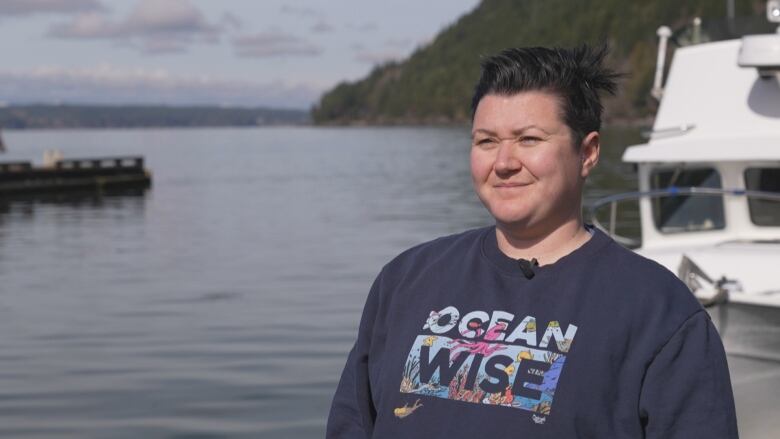'CSI on the ocean': Whale researchers comb B.C. waters for eDNA
Data gathered using non-invasive technique could expedite future conservation efforts, say researchers

It was just after 8 a.m. when Gary Sutton and his crew spotted thesignature black dorsal fins cutting through the coolwaters of theSalish Sea,off the coast of Vancouver Island.
More than a dozen Bigg's killer whales, alsoknown as transient killer whales,swimming north in search of food. They surfaced every few minutes, the spray of their respiration punctuating the otherwise quiet wintermorning.
While few things command presence of mind quite like the sudden appearance of a pod of whales, Sutton,a research technician with the non-profit conservation group Ocean Wise, and his fellow researchers have spent more than a week on the water regularly observingthe whales andcombing for data that might assist theanimals in the not-so-distant future.
They have beencollecting water samples to study the environmental DNA (eDNA) ofBigg's killer whales, North Pacific humpbacksand B.C.'s endangered southern resident killer whales.
An emerging approach to studying marine life, the researchers believeeDNAcould assist whale recovery, byproviding better data around the mammals' prey andecosystems information that could produce better strategies for conservation.
"It's like CSI in the ocean," he said.
Less invasive approach
A comparatively new field of research,eDNAoffers scientistsa non-invasive way to study marine lifeby analyzing mucus, feces, andother tissue particlesshed by animals into the water, in order to determine what Sutton calls their "genetic footprint," including the sex and even the paternity of individual whales, which often remains a mystery.

The approach is considered less invasive than thetraditional method, which centres on tracking animals and then gathering a biopsy for analysis.
"I can countprobably on one handthe number of papers that have been published focusing on eDNA for whales in particular,"said Chloe Robinson,Ocean Wise's director of whales."We'redoing a lot of the work to standardize the methods."
Robinsonsays B.C.'s southern resident killer whales are a "fantastic population to trial thesenoninvasive eDNA methods" because their small size has allowed them to be thoroughly studied, offering researchers troves of "hard data" to compare with the neweDNAgathered.
She adds thateDNA is also useful in monitoring the prey whales are eating, and thebroader genetic makeup of various species.
Symbol of B.C.'s south coast
A symbol of the province's south coast, inspiring everything from sightseeing tours to souvenirs andB.C. Ferries signage, B.C.'s southern resident killer whalepopulation has spent several decades in decline.
"A lot of the obstacles they face are because of us," said Sutton, pointing tothe rampant capturing of killer whales along the coast between B.C. and Washington state in the 1960s and '70s, which saw manyanimals caught and sold to aquariums around the world.
The U.S. Environmental Protection Agency estimates, between 1967 and 1971, the killer whale population declined by 30 per cent.
In 1975, Canada banned the capture of killer whales. However the population has struggled to recover in subsequent decadesamidmyriadissues, including a lack of prey, pollution, ship strikesand noise.
At time of publication, B.C.'s southern resident killer whale population is 75.
'Immediate effective action'
Few peoplewill ever see a killer whale pod upclose. Sutton,however, knows the groupwell enough that he can identify certain whales usingsubtle markers including the size of their dorsal fins, eye patchs and saddle patch shape.
From the top deck of the group'seight-metrelongboat, he saw that the pod, which hesaidincludes at least three different family groups, hadgrown ever so slightly.
"One of the older females, T124A1, has a calf," he said. "It's her first calf, which is really exciting."
After a whale breaches, researchers move swiftly sometimes as quick as 90 seconds, according to Suttonto scoop up the water it was swimming in, before filteringit on the boat.
The sample is later analyzed for select "primers" target sequences of genetic material.
The Department of Fisheries and Oceans saysis exploring the use of eDNA tools."Through the study of genetic material shed by organisms in their environment, eDNAcanhelp us detect which species, native or not, are in our waters," the department wrote in an email to CBC.
"For instance, through early detection of aquatic invasive species,we can take preventative actions sooner," they said.
While not focused specifically on recovery, the Ocean Wise researchers hope the current study could inform strategies moving forward.
"[These techniques] mean more targeted conservation efforts so you can have the best bang for your buck, and immediate effective action," said Sutton. "That's what these animals are in dire need of."
With files from Georgie Smyth and Andrew Lee













_(720p).jpg)


 OFFICIAL HD MUSIC VIDEO.jpg)
.jpg)



























































































